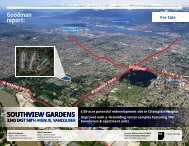Canada
MER-Canada-2016
MER-Canada-2016
You also want an ePaper? Increase the reach of your titles
YUMPU automatically turns print PDFs into web optimized ePapers that Google loves.
TECHNICAL COMPLIANCE ANNEX<br />
In addition, trust companies are required when acting as trustee of a trust (ss.55 (a)-(c)) to (i) of the<br />
PCMLTFR) to ascertain the identity of every person who is the settlor of an inter vivos trust:<br />
(ii) confirm the existence of, and ascertain the name and address of, every corporation that is the<br />
settlor of an institutional trust; and (iii) confirm the existence of every entity, other than a<br />
corporation, that is the settlor of an institutional trust. Under the Regulations (s.55 (d)), where an<br />
entity is authorized to act as a co-trustee of any trust, the trust company must (i) confirm the<br />
existence of the entity and ascertain its name and address; and (ii) ascertain the identity of all<br />
persons—up to three—who are authorized to give instructions with respect to the entity’s activities<br />
as co-trustee. Finally, under the Regulations (s.55 (e)), trust companies must ascertain the identity of<br />
each person who is authorized to act as co-trustee of any trust. However, as natural persons who are<br />
trustees are not REs under the PCMLTFA, they are not subject to CDD obligations.<br />
PCMLTFR ss 11 (a)-(b) require trust companies, for inter vivos trusts, to (i) keep a record that sets<br />
out the name and address of each of the beneficiaries that are known at the time that the trust<br />
company becomes a trustee for the trust; (ii) if the beneficiary is a natural person, record their date<br />
of birth and the nature of their principal business or their occupation; and (iii) if the beneficiary is an<br />
entity, the nature of their principal business.<br />
Technical compliance Annex<br />
Criterion 10.10— The legal requirements for obtaining information on beneficial owners of<br />
customers that are legal persons are set out under c.10.5 above.<br />
REs must confirm the existence of a corporation or non-corporate legal entity at the opening of an<br />
account or when conducting certain transactions. At the same time, they must obtain information<br />
about the entity's beneficial ownership and confirm its accuracy. Beneficial ownership refers to the<br />
identity of the individuals who ultimately control the corporation or entity, which extends beyond<br />
another corporation or another entity. The PCMLTFR requirements for corporations and other<br />
entities refer to “persons.” PCMLTFA, s.2 defines “person” to mean an individual, which therefore<br />
requires the natural person to be identified. If the RE has doubts about whether the person with the<br />
controlling ownership interest is the beneficial owner, then it is deemed to have been unable to<br />
obtain the information referred to under PCMLTFR, s.11.1(1) or to have been unable to confirm that<br />
information in accordance with PCMLTFR, s.11.1(2). In this case, the RE is required, under PCMLTFR<br />
s.11.1(4), to: take reasonable measures to ascertain the identity of the most senior managing officer<br />
of the entity; treat that entity as high risk for the purpose of PCMLTFA, s.9.6(3) and apply the<br />
prescribed special measures set out in PMCLTFR, s.71.1. Where no individual ultimately owns or<br />
controls 25% or more of an entity, directly or indirectly, REs must nevertheless record the measures<br />
they took, and the information they obtained, in order to reach that conclusion. Also, REs must<br />
comply with PCMLTFR, s.11.1(1)(d), which requires that information “establishing the ownership,<br />
control and structure of the entity” be obtained.<br />
Criterion 10.11— The legal requirements for collecting information on the identity of beneficial<br />
owners of customers that are legal arrangements are set out under c.10.5 and 10.9 above. It is<br />
unclear, in the case of trusts, what identification requirements apply to protectors. Beneficiaries of<br />
trusts are covered by the ongoing monitoring provisions of s. 1(2) of the Regulations, which require<br />
that client identification information and information be kept up to date.<br />
142<br />
Anti-money laundering and counter-terrorist financing measures in <strong>Canada</strong> - 2016 © FATF and APG 2016




